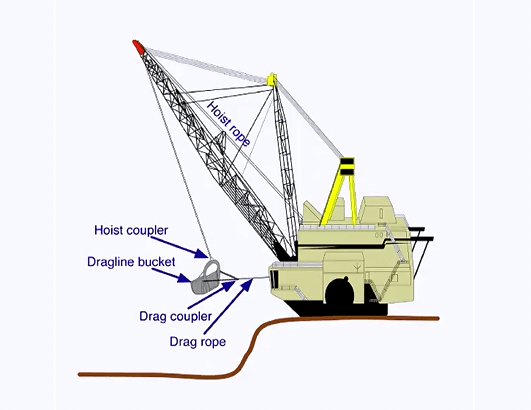See This Report about Excavation Companies
Wiki Article
The Single Strategy To Use For Excavator
Table of ContentsExcavation Contractors Near Me - QuestionsThe Ultimate Guide To Excavating ContractorsExcitement About ExcavatorThe 25-Second Trick For ExcavatorThe 8-Second Trick For Concrete Contractors


Scrapers or Pans excavate soil in one area, haul and dispose the dirt in another spot (excavation contractors near me). It is hard to match the performance of scrapes for cut/fill dirt operation if the haul distance is much less then a mile. Scrapes are usually pulled by a rubber tire wheel tractor as well as are in some cases pressed with the cut area by a bulldozer.
There are many times that scrapers are not used for website grading and also a dump vehicle is used: the haul might be to long, the haul might go across roadways where scrapes are not allowed, acid rock might be come across, devices schedule, and so on. Discard vehicles are in typical use as well as most likely call for little discussion.
Lots of trucks have a top-hinged tailgate that can not unload any type of rock wider after that the tailgate width. "Rock body" beds, on the various other hand, have no tailgates as well as can discard any type of size rock, although their quantity ability is reduced. These web links show tools specifications for several typical dump trucks. Compaction Equipment increases the thickness of the dirt and sometimes supplies a smooth, rolled surface area.
Examine This Report about Demolition
From a straightforward examination pit to percussion drilling to core drilling the proprietor has progressively extra pricey alternatives that produce progressively better information regarding the website underground. The Proprietor on a 100,000 SF structure job may accredit twenty boring places with split spoon soil examples taken up until rock is reached as well as after that core examples of rock.Recognizing the type and also high quality of rock (from the core examples) and area of rock (from the dirts boring) is a genuine benefit in jobsite preparation. Conversely, the Owner of a 100,000 SF building might decide to proceed with no geotechnical testing whatsoever. The decision about geotechnical testing is typically made by an Owner with no input from the Construction Manager.
The section on Dirts and Geology helps you comprehend the terms in the geotechnical record. An expertise of the approximate location of the rock assists the Construction Supervisor to intend the sequence of actions adhering to rock excavation. If rock is in one edge of a huge structure task, as an example, the planet excavation could begin at the opposite end of the structure in order to begin structure job soonest.
Beginning the structure work early would be a great concept if the rock could be eliminated by ripping. Nonetheless, if the rock is extremely hard and requires substantial blasting, it might be prudent to hold structure work up until the blasting is finished. The Building and construction Manager must collaborate these kinds of choices and also make use of all the technological day available.
The Basic Principles Of General Contractor
Unclassified excavation stipulates that all rock or various other unforeseen products (omitting unsafe materials) run into in the sitework will certainly be the duty of the Contractor at no adjustment in contract price. An unclassified excavation is less complex from a book-keeping standpoint and places the duty for geotechnical problems onto the Sitework Contractor.Just How Water Affects Sitework? It's incredible what a hefty rainfall can do to a construction job. Prior to the rainfall, the website might be completely dry, heavy devices efficiently relocating planet, the various other trades smoothly performing their job. Within hours the job can be a sloppy, mud-hole with employee effectiveness cut to about 10%.
In many areas of the world, the Construction Supervisor must remember a straightforward fact: IT WILL RAINFALL. Great preparation can lessen the damage as well as disruption of a heavy rain to a jobsite. Often the excavation and grading is delegated the Sitework Specialist (as well as their Foremen is liable to oversee and route the heavy equipment and operators).
The Construction Supervisor have to be continuously mindful of what rain will certainly do to the job website. It is not unusual for the Sitework Supervisor to function their heavy equipment for maximum effectiveness and wish it doesn't rainfall. Among the most effective methods to get ready for rainfall is to incline all grades to drain as well as to smooth this article rolled the surface before a rain.
Indicators on Excavating Contractors You Should Know
The Construction Supervisor must be discerning adequate to insure that heavy rainfall does not quit work on the task longer than necessary. Daily discussions with Sitework Foremen might be needed to achieve this objective. Whenever excavation is required below the existing water level on a task, the procedure of dewatering have to be considered.In a truly natural dirt, the water takes a trip so slowly via the clay or silt that dewatering is not typically needed for the fairly short time of excavation. Dewatering might be required for a solitary footing excavation or for an entire project website. The most common dewatering techniques are trench drains, deep wells and also well points.

Ground water infiltration can additionally be reduced by cutoff approaches such as sheet loading. The prices for dewatering can be staggering, including equipment service, labor and also electrical power (or fuel). High dewatering prices have paled the revenue margins on much way too many tasks. The lots of variables detailed below make the job of estimating dewatering expenses really tough, and also very inexact.
This choice needs to constantly be thought about when examining the prospect of dewatering. Undoubtedly the option is only feasible if gravity can run the water to reduced ground. Trench drains can be cut with a backhoe and also full of a rugged, granular material (# 4 rock for instance), but care has to be exercised in choosing the water outlet type and also location.
A Biased View of Excavator
A siphon, necessarily, uses atmospheric stress to carry water from one altitude, up over a barrier, to a lower altitude. The pipes in a siphon system should be airtight and also some ingenuity is frequently called for to completely load the siphon pipeline. The siphon pipeline must be full for the siphon to start.A deep well this includes a pump, tube as well as a vertical well casing. The pump intake is at the base of the well casing (normally some crushed rock is put there as a filter medium) (excavation companies). The water is pumped up the tube, out of the well housing, and also to a suitable discharge area.
In a crude sand, as an example, a big location can be pumped to near the pump intake elevation. A much less absorptive dirt, on the other hand, lowers the effectiveness of a deep well. Given that the pump is normally at the end of the deep well, there are no elevation limitations because of vacuum lift, and also deep wells can lower the groundwater over 50 feet.
Under of the wellpoint there is a 2 foot long screen as well as valve, water jets out of this valve as well as produces a hole into which you can check here the wellpoint pipe can be decreased. This opening is commonly made a bigger diameter (as an example 10 inches) to enable a rugged sand backfill to assist filter the water (trencher).
Report this wiki page